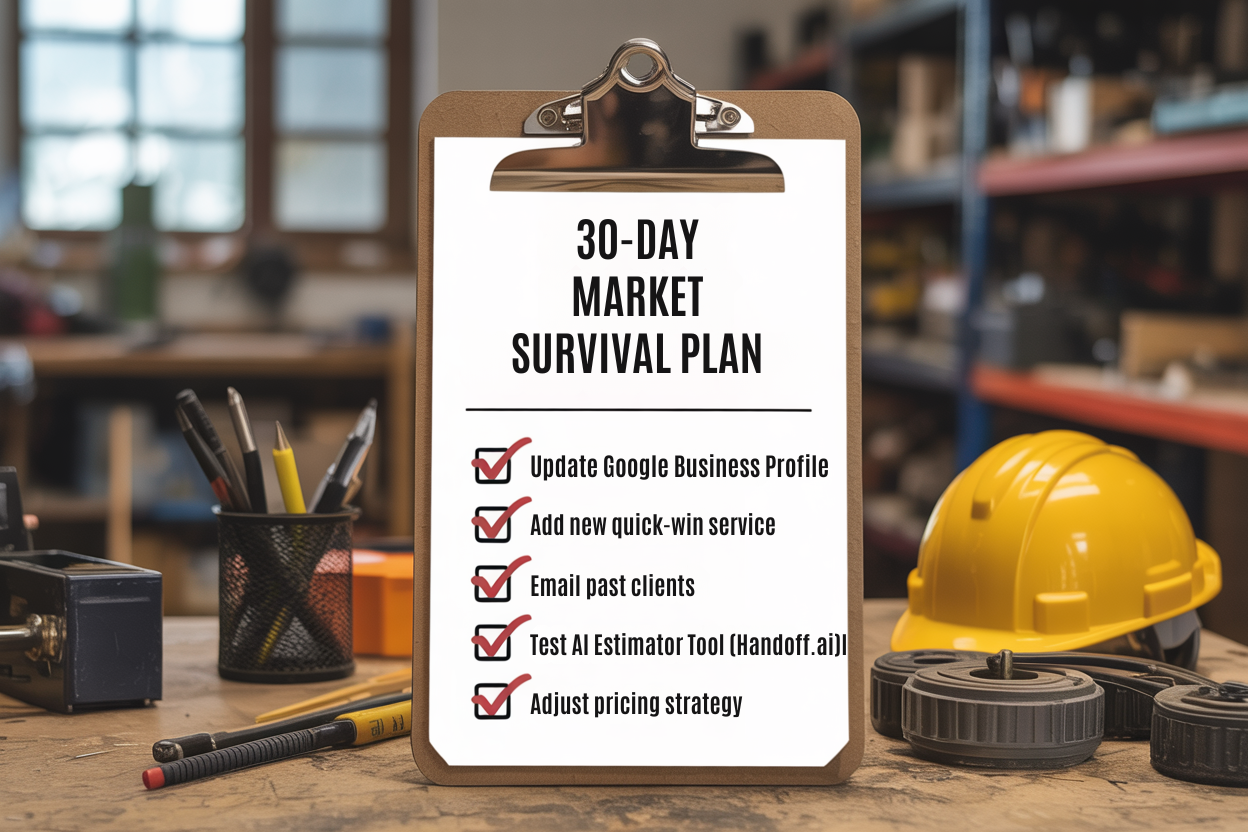The phone isn't ringing as much as it used to. Inquiries are slowing down, and jobs are taking longer to close. For many in the construction and remodeling industry, these are the first signs of a cooling housing market, and it's natural to feel a sense of anxiety.
When home sales slow, it's a common misconception that the work will dry up entirely. However, this represents a critical misunderstanding of homeowner behavior during economic uncertainty.
The fundamental truth is this: when people stop moving, they start improving. Rather than viewing a slow housing market as an obstacle, successful contractors recognize it as an opportunity to pivot their strategies and capture a different segment of demand. This comprehensive guide will demonstrate how to adapt your approach to keep your pipeline full, protect your margins, and even grow your business, regardless of the housing market's fluctuations.
What a Slow Housing Market Really Means for Contractors
A slowdown in the housing market is typically characterized by several interconnected factors: rising interest rates, inflated home prices, and diminished consumer confidence. These elements create a perfect storm that deters potential homebuyers from entering the market. However, the critical insight for contractors is that these same factors do not eliminate the need for home improvements, they fundamentally reshape it.
The traditional "buy-and-remodel" trend gives way to a "stay-and-remodel" mindset. Homeowners who find themselves priced out of the moving market or locked into favorable mortgage rates become prime candidates for significant home improvements. This demographic shift creates new opportunities for contractors who understand how to position their services appropriately.

This behavioral shift was particularly evident during the 2020–2023 housing market cooldown, where contractors who successfully adapted their service offerings and marketing strategies not only survived but thrived. The key was recognizing that homeowner priorities had shifted from luxury upgrades to practical, value-adding improvements.
Five Strategic Approaches to Maintain Pipeline Flow During Market Slowdowns
1. Realign Your Service Offerings with Current Market Demand

During periods of economic uncertainty, homeowner priorities shift dramatically toward practical value over luxury aesthetics. The most successful contractors recognize this transition and adjust their service portfolios accordingly. Rather than promoting comprehensive luxury remodels, focus on projects that deliver measurable returns on investment and address immediate homeowner needs.
High-Demand Services in Slow Markets:

The key messaging shift involves reframing your value proposition from "luxury remodel" to "maximize your home's value and functionality." This approach appeals directly to the practical concerns that dominate homeowner decision-making during uncertain economic times.
2. Target the "Stay Put" Demographic with Precision Marketing

Rising mortgage rates create a captive audience of homeowners who are economically incentivized to remain in their current properties. This demographic represents your most valuable lead source during market slowdowns. These homeowners often have equity built up in their homes and are motivated to invest in improvements rather than face the financial burden of moving.
Primary Target Segments:
- Growing families requiring additional space or functional improvements
- Empty nesters adapting their homes for retirement and aging in place
- Remote workers needing dedicated office spaces or improved home functionality
- Long-term homeowners with significant equity and deferred maintenance needs
Effective marketing campaigns should center around emotional and practical themes such as "love your home again," "make your home work for you," and "unlock your home's potential." These messages resonate with homeowners who are committed to their current properties but seeking to optimize their living experience.
3. Diversify with Smaller, High-Velocity Services

While major renovation projects may experience longer sales cycles during economic uncertainty, smaller improvement projects maintain consistent demand. These "quick win" services serve multiple strategic purposes: they provide immediate cash flow, require lower customer commitment, and often serve as entry points for larger future projects.
Recommended Quick-Win Services:
- Cabinet refacing and hardware updates
- Bathroom fixture and vanity replacements
- Flooring installation and refinishing
- Interior and exterior painting
- Lighting fixture upgrades and electrical improvements
These services typically close faster because they require smaller financial commitments from homeowners who may be hesitant about major expenditures. Additionally, successful completion of smaller projects builds trust and positions you for larger opportunities when market conditions improve.
4. Increase Marketing Investment While Competitors Retreat

Market downturns create a paradoxical opportunity for growth-minded contractors. While most competitors reduce their marketing efforts to cut costs, this creates an opening for increased market share capture. The contractors who maintain or increase their visibility during slow periods often emerge stronger when markets recover.
Strategic Marketing Priorities:
- Google Business Profile optimization with fresh content, photos, and customer reviews
- Local SEO investment to capture search traffic from competitors who have reduced their online presence
- Social media content creation featuring project walkthroughs, before-and-after showcases, and educational content
- Content marketing focused on market-relevant topics such as home value optimization and energy efficiency
Position yourself as the local authority by publishing content that addresses current homeowner concerns. Topics such as "Home Improvements That Increase Value in 2025" or "Energy-Efficient Upgrades That Pay for Themselves" demonstrate expertise while addressing practical homeowner interests.
5. Implement Strategic Pricing Without Compromising Profitability

The instinct to lower prices during slow markets often leads to a destructive race to the bottom that erodes industry profitability. Instead, successful contractors implement smarter pricing strategies that maintain margins while addressing customer price sensitivity.
Effective Pricing Strategies:
- Phased project proposals that allow homeowners to spread costs over time
- Flexible payment options including financing partnerships to reduce upfront cost barriers
- Tiered service packages offering good-better-best options to accommodate different budgets
- Value-based pricing that emphasizes return on investment rather than lowest cost
Utilize technology and market analysis tools to ensure your pricing reflects true market value. The goal is to position your proposals as the best value rather than the cheapest option, emphasizing quality, reliability, and long-term benefits.
Leveraging Artificial Intelligence for Competitive Advantage

The integration of artificial intelligence into contractor operations represents a significant opportunity to gain competitive advantages during market slowdowns. AI technology can provide small and medium-sized contractors with capabilities traditionally available only to large enterprises, enabling them to operate more efficiently and respond more quickly to market opportunities.
Key AI Applications for Contractors:

The strategic advantage of AI implementation becomes particularly pronounced during slow markets when every lead becomes more valuable. Contractors who can respond to inquiries within minutes rather than hours, provide detailed estimates quickly, and maintain consistent follow-up communication will capture a disproportionate share of available business.
Immediate Action Plan: Seven Critical Steps for Market Adaptation

The following action items represent the most impactful steps contractors can take immediately to position themselves for success during market slowdowns. Each item is designed to be completed within a single month and will provide measurable improvements to business performance.
Week 1: Digital Presence Optimization
- Update your Google Business Profile with current keywords, high-quality project photos, and regular posts showcasing recent work
- Audit and improve your website for mobile responsiveness and local SEO optimization
Week 2: Service Portfolio Expansion
- Add at least one new "quick win" service to your offerings, focusing on high-demand, lower-cost improvements
- Develop tiered pricing packages for your most popular services to accommodate different budget levels
Week 3: Content Marketing and Outreach
- Create and publish content about remodeling ROI, energy efficiency, or home value optimization for 2025
- Email your past client database with a seasonal upgrade offer or maintenance reminder
Week 4: Lead Management and Technology
- Follow up with every lead from the past 90 days using a systematic approach
- Research and implement one AI tool for lead follow-up automation or proposal generation
- Review and adjust your pricing strategy based on current market conditions and competitor analysis
Conclusion: Positioning for Long-Term Success

Market slowdowns serve as a crucial test of business resilience and strategic thinking. While many contractors may view these periods as obstacles to overcome, the most successful professionals recognize them as opportunities for competitive differentiation and market share growth.
The contractors who emerge stronger from slow markets are those who adapt their strategies, embrace new technologies, and maintain their commitment to customer service excellence.
The fundamental principle remains unchanged: when homeowners stop moving, they start improving. By aligning your services with this reality, implementing strategic marketing approaches, and leveraging technology for operational efficiency, you can not only survive market downturns but use them as catalysts for business growth.
The tools and strategies outlined in this guide provide a roadmap for transformation. For contractors ready to make this strategic shift, the current market environment offers an unprecedented opportunity to establish market leadership while competitors retreat. The question is not whether the market will recover, it will, but whether you will be positioned to capitalize on that recovery when it arrives.















